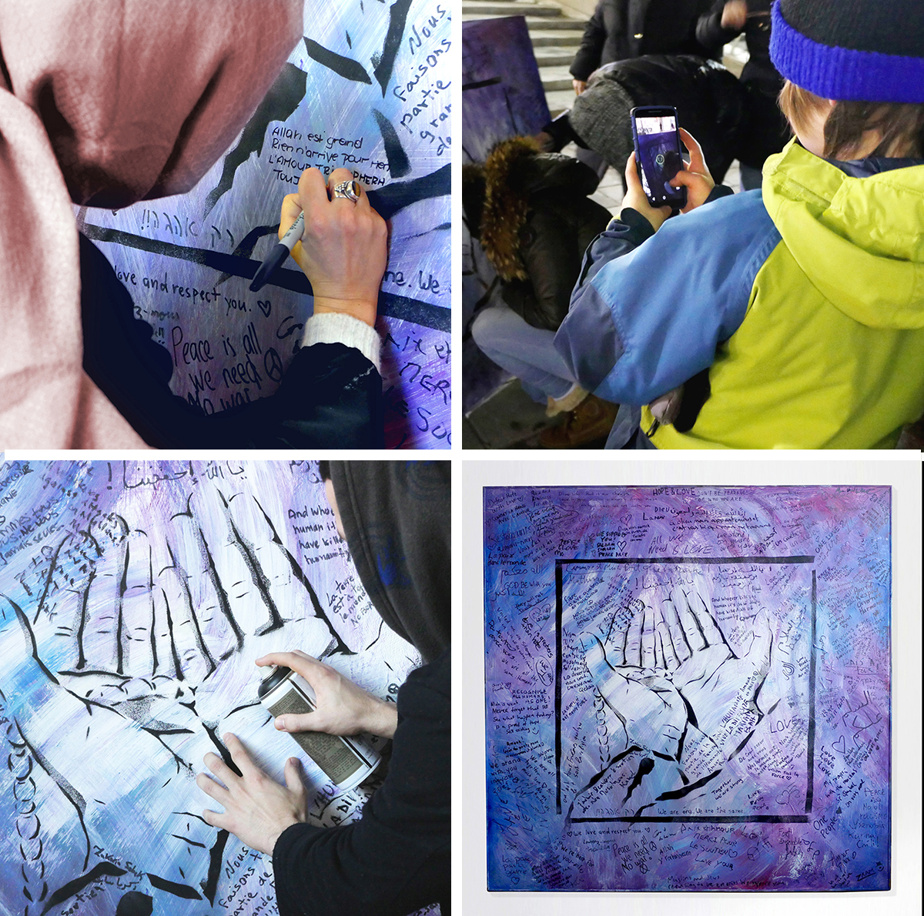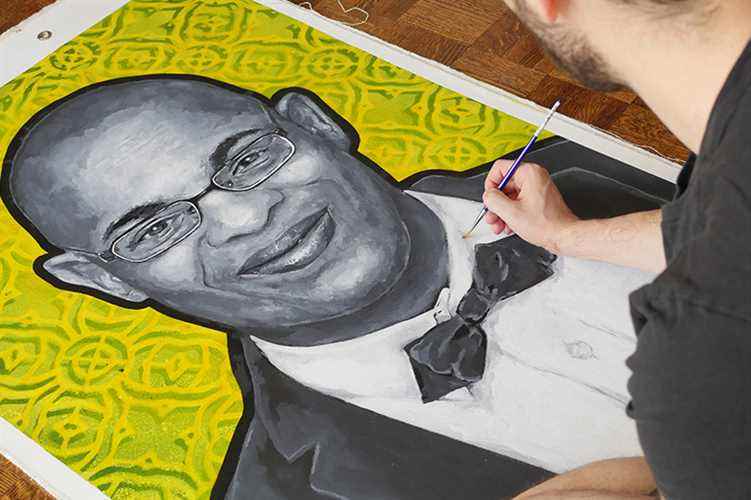Canadian artist Aquil Virani has produced a series of paintings in tribute to the six people killed in the attack on the Grand Mosque of Quebec on January 29, 2017. To mark the fifth anniversary of the tragedy, these works will be exhibited, from Saturday, at the Islamic Cultural Center of Quebec before being offered to the families of the disappeared.
Posted at 8:00 a.m.
On the evening of January 29, 2017, at prayer time, a 27-year-old man, political science student at Laval University, Alexandre Bissonnette, opened fire on about fifty worshipers of the mosque of the Islamic Cultural Center of Quebec. The attack killed six people and injured eight.
The six people murdered are computer scientists Ibrahima Barry, 39, and Abdelkrim Hassane, 41; accounting technician Mamadou Tanou Barry, 42; middle manager Aboubaker Thabti, 44, shopkeeper Azzedine Soufiane, 57, and Laval University professor Khaled Belkacemi, 60.

PHOTOMONTAGE PROVIDED BY AQUIL VIRANI
Stronger Together was created during the rally in Montreal, on January 30, 2017.
The day after the killing, a solidarity rally for Muslims in Quebec was organized at the Parc metro station in Montreal. Then domiciled in the metropolis, Aquil Virani had participated. There, he had created a collaborative work, Stronger Together, a painting of the hands of a Muslim person praying. Dozens of participants in the rally had added messages of hope, solidarity and condolences.
“During this vigil, I had met a Muslim woman who put me in touch with one of her Muslim friends from Quebec, Amira Bahmed, who allowed me to deliver Stronger Together at the mosque in Quebec City, where she still is, and to meet members of one of the bereaved families,” says the 31-year-old artist.

PHOTO MARTIN CHAMBERLAND, THE PRESS
Aquil Virani
Born in Vancouver to a Muslim father from India and a Buddhist mother born in France, Aquil Virani has lived in Toronto since his wife found a job there. He studied philosophy and marketing at McGill.
The following year, in 2018, he also paid tribute to the diversity of Canadian women with the corpus Let’s CelebrateThe (CelebrateHer), a series of 12 portraits. “One of the widows of the tragedy saw the portrait and a video I had made with a Muslim woman, Zébida Bendjeddou, Amira’s mother, and contacted her to tell her that she liked the portrait I had made of her. She wondered if I was open to creating a series of portraits of the six victims of the attack. »
-

PHOTO PROVIDED BY AQUIL VIRANI
The portrait of Zébida Bendjeddou, painted by Aquil Virani
-

PHOTO PROVIDED BY AQUIL VIRANI
Let’s CelebrateThe (CelebrateHer), a series of 12 portraits paying tribute to the diversity of Canadian women
1/2
At first, Aquil Virani thought it was too early for such a project. He did not want to rush things and wanted to do so in partnership with the Muslim community of Quebec. “Zébida then contacted me to tell me that it was a good idea,” he says. Each of the families was then asked if they wanted to give their consent and they agreed. The families provided photos of the victims, and for three years Aquil Virani painted the portraits in acrylics and spray paint on canvas.
-

PHOTO PROVIDED BY THE ARTIST
The paintings of three of the six victims. From left to right: Abdelkrim Hassane, Mamadou Tanou Barry and Khaled Belkacemi
-

PHOTO PROVIDED BY THE ARTIST
From left to right: paintings by Aboubaker Thabti, Azzedine Soufiane and Ibrahima Barry
1/2
I wanted to express the details of the exact expression of the person in each photo. The happiness that often emanated from it.
Aquil Virani
“Some families haven’t seen the portraits yet. But I went, in 2019, to show Khaled Belkacemi’s to his family. It was the first one I had finished. They appreciated my visit. I was able to explain my artistic choices to them. »

PHOTO PROVIDED BY AQUIL VIRANI
The artist presents the portrait of Khaled Belkacemi to his family in October 2019.
The 30″ x 65″ works will be on display for a week or two at the mosque, the artist plans. “It will depend on the rules of the pandemic,” he said. His project was made possible by a $1,500 federal grant obtained through the community organization TakingITGlobal. Mme Bahmed, who is the coordinator in Quebec, organized the project for Aquil Virani.

PHOTO PROVIDED BY AQUIL VIRANI
The portrait of Khaled Belkacemi shown in front of the Islamic Cultural Center of Quebec, in 2019. “To show it in the public space for a few hours”, says the artist.
Aquil’s project was well received by the Muslim community. It was tricky and a long communication process. It was done with respect.
Amira Bahmed, Muslim from Quebec
“What I like about Aquil’s work is that you feel the person. For the portrait of my mother, I felt her inner peace, her gentleness and her strength. Same thing for that of Mr. Belkacemi, a smiling and imposing man. To see these six portraits, in a large format, has a powerful impact. We will never forget them. »
This fascination for diversity is not new. In 2014, Aquil Virani had made a corpus, after crossing the country, creating Canada’s Self-Portrait, an installation made of drawings that reproduced some of those that 800 Canadians aged 3 to 86 had entrusted to him.

PHOTO ALEX TRAN, PROVIDED BY AQUIL VIRANI
Detail of the work Canada’s Self-Portrait
Currently, the artist is in residence at the Canadian Museum of Immigration, Halifax. He created a collaborative project for the museum entitled Our Immigrant Stories, collecting testimonials from immigrants living across Canada. His exhibition will be held in March.

